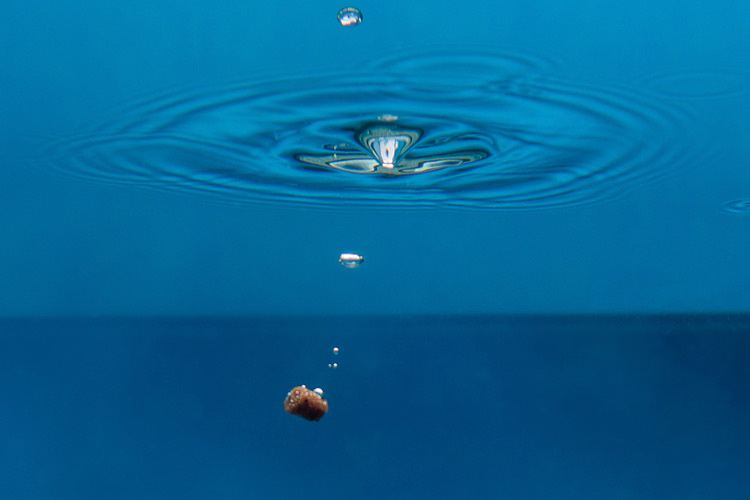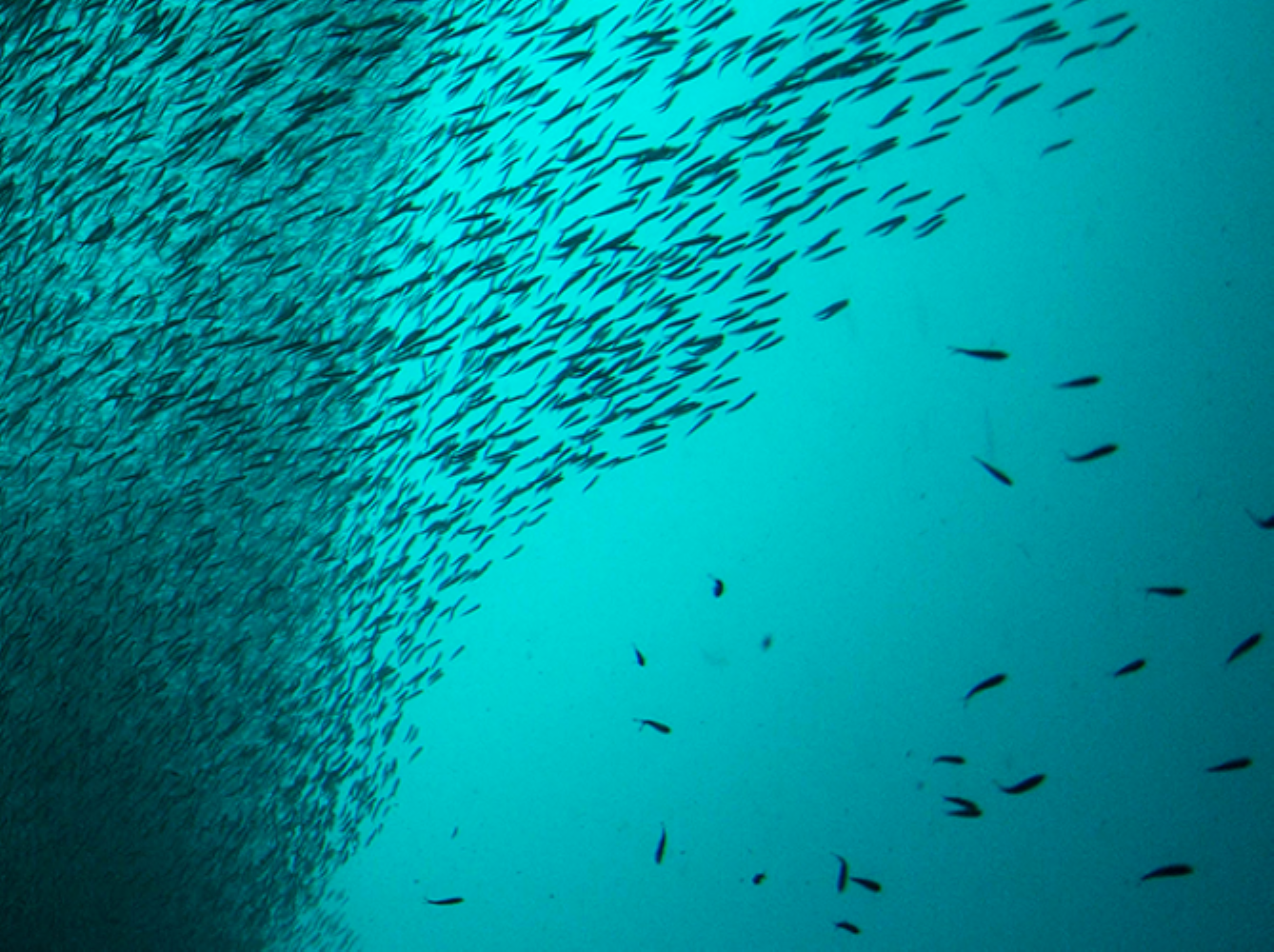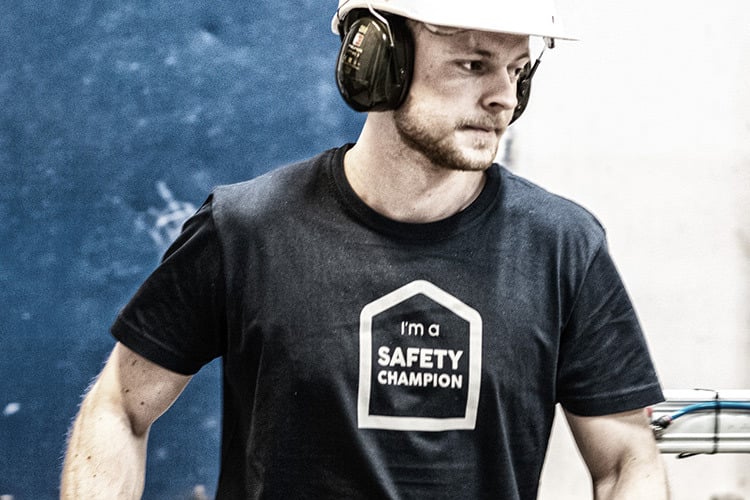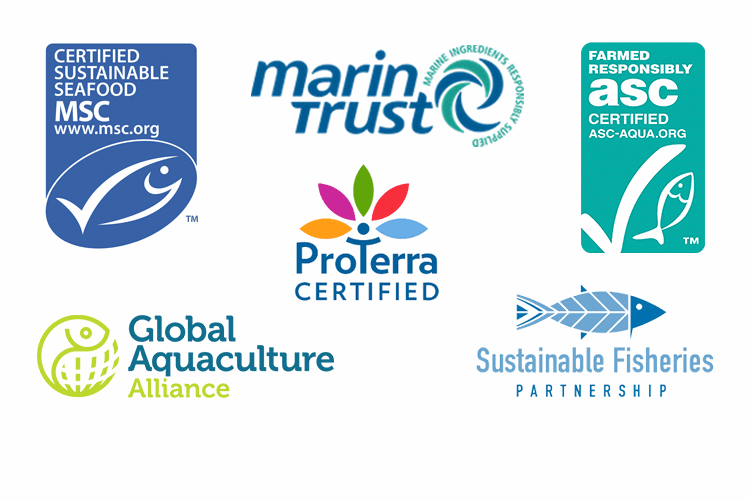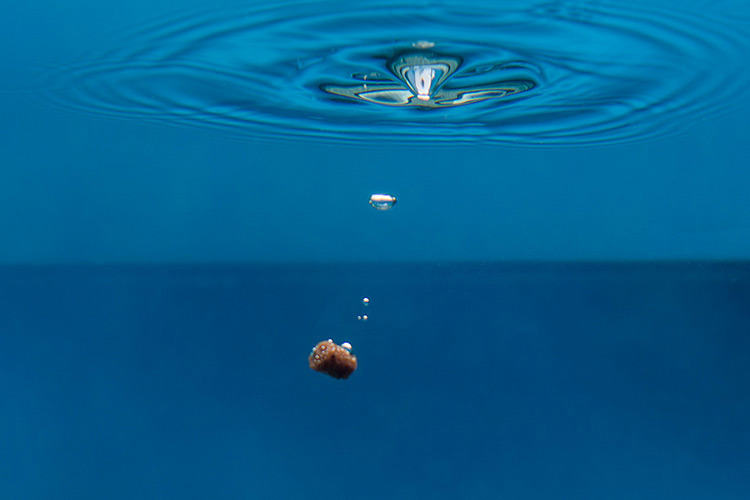
Use of marine raw materials 2024
We strive to balance the need to produce feed for healthy meals for both fish and human consumption with our goal to be an environmentally responsible producer. We do this by sourcing sustainable feed ingredients and a focus on reduced dependency on wild fish for feed. We only use whole fish that are either certified (MSC or MarinTrust) or subject to a Fishery Improvement Project (FIP).
In 2024 it took 0.49* kg wild fish to produce 1 kg of feed. 36.5 percent of this fish meal and fish oil originated from trimmings. Almost 99 percent of these marine ingredients used in 2024 was certified or from a FIP.
Please note that even though we have a policy to only use whole fish that are either certified or from a FIP, a hundred percent certification level is not practical to achieve because of the use of trimmings and legal by-catch, which ensures that we do not waste valuable bio-resources from the circular economy. That is why the number of not certified/FIP in 2024 was 1.3 percent and not zero.
* FIFO, according to: Jackson, A. 2009. Click here to scroll down to FFDRm and FFDRo data.
Shortcuts to the marine raw materials tables on this page
- Certification status marine raw materials (overview)
- Trimmings proportion in fish meal and fish oil
- Kg wild fish per kg feed, FFRD and FIFO
- Certification status fish meal from whole fish
- Certification status fish meal from trimmings
- Certification status fish oil from whole fish
- Certification status fish oil from trimmings
- FFDRm, use of wild fish in feed, fish meal
- FFDRo, use of wild fish in feed, fish oil
- Origin of fish meal from whole fish
- Origin of fish meal from trimmings
- Origin of fish oil from whole fish
- Origin of fish oil from trimmings
- Origin of fish meal and fish oil from farmed fish
Certification status marine raw materials (fish oil and fish meal from both whole fish and trimmings)
| 2024 | 2023 | 2022 | 2021 | 2020 | |
| MSC | 23.0 % | 27.1 % | 34.4 % | 53.6 % | 64.3 % |
| MarinTrust | 41.7 % | 40.3 % | 51.0 % | 42.7 % | 31.7 % |
| MSC ITM* | 2.3 % | 0.2 % | - | - | - |
| Comprehensive FIP | 1.6 % | 3.7 % | 1.2 % | - | - |
| MarinTrust FIP | 30.1 % | 25.3 % | 10.8 % | 2.2 % | 0.8 % |
| None** | 1.3 % | 3.4 % | 2.6 % | 1.6 % | 3.2 % |
| Total | 100% | 100% | 100% | 100% | 100% |
* Marine Stewardship Council's Improvement Program "In-Transition to MSC" (MSC ITM) began as a pilot program in 2019 and is now an established framework that complements the existing efforts of the many fisheries improvement projects (FIPs) working around the world.
** The number for "None" is mainly due to trimmings and legal by-catch, important bio-resources from the circular economy that must not be wasted and where the amount will vary year from year.
Trimmings proportion in fish meal and fish oil
| 2024 | 2023 | 2022 | 2021 | 2020 | |
| Proportion fish meal from trimmings | 25.0 % | 20.8 % | 32.8 % | 20.5 % | 13.7 % |
| Proportion fish oil from trimmings | 52.2 % | 33.1 % | 39.3 % | 31.5 % | 16.6 % |
| Trimmings of marine raw materials (meal and oil combined) | 36.5 % | 25.9 % | 35.4% | 25.3 % | 15.0 % |
Kg wild fish per kg feed, Forage Fish Dependency Ratio for feed and FIFO
| 2024 | 2023 | 2022 | 2021 | 2020 | |
| FFDR for fish meal per kg feed (FFDRm) | 0.43 | 0.51 | 0.46 | 0.43 | 0.44 |
| FFDR for fish oil per kg feed (FFDRo) | 0.69 | 1.03 | 1.04 | 1.09 | 1.39 |
| FIFO* | 0.49 | 0.63 | 0.59 | 0.57 | 0.63 |
*FIFO excluding trimmings, according to: Jackson. A. 2009.
Below is more granulated data for certification status, FFDR and the origin of fish meal and oil respectively used in Skretting Norway's feed.
Certification status of marine raw materials
Skretting Norway only buys marine raw materials from whole fish that are either certified (MSC or MarinTrust) or subject to a Fishery Improvement Project (FIP).
Almost 99 percent of the fish meal and fish oil used in 2024 was certified or from a FIP. The rest is mainly due to trimmings and legal by-catch.
Source of marine raw materials
Wild fish harvested from the ocean and processed into fish meal and fish oil are ingredients in fish feeds. Small pelagic fisheries are used in the fish meal and fish oil industry, but in some regions they are also important for direct human consumption. Also known as forage species, these are small, short-lived species that occupy a low trophic level (LTL) in the ecosystem. Due to their specific population biology and dynamics, these species are frequently resilient to fishing pressure if catches are well managed, but overfishing is always a possibility without effective controls. We strive to ensure that marine-based feed ingredients come from sustainable sources in the short- and long-term. The requirements aim to align industry incentives to support processes that will lead to improved fisheries management.
Fish meal from whole fish certification status
| 2024 | 2023 | 2022 | 2021 | 2020 | |
| MSC approved | 5.8 % | 20.7 % | 25.1 % | 59.3 % | 85.0 % |
| MarinTrust | 36.3 % | 28.4 % | 55.9 % | 35.5 % | 14.0 % |
| MSC ITM | 0.2 % | ||||
| Comp FIP | 1.6 % | 1.6 % | 1.2 % | - | - |
| MT FIP | 55.2 % | 46.2 % | 16.0 % | 4.2 % | - |
| None | 0.8 % | 3.0 % | 1.7 % | 0.9 % | 1.0 % |
| Total | 100% | 100% | 100% | 100% | 100% |
Fish meal from trimmings certification status
| 2024 | 2023 | 2022 | 2021 | 2020 | |
| MSC approved | 33.6 % | 38.5 % | 31.0 % | 56.0 % | 70.0 % |
| MarinTrust | 59.5 % | 57.7 % | 59.7 % | 37.9 % | 23.0 % |
| MSC ITM | 2.6 % | ||||
| Comp FIP | 2.5 % | 0.0 % | - | - | - |
| MT FIP | 0.2 % | 1.4 % | 4.6 % | - | - |
| None | 1.7 % | 2.4 % | 4.7 % | 6.2 % | 7.0 % |
| Total | 100% | 100% | 100% | 100% | 100% |
In 2024 25.0 % of the fish meal came from trimmings. The rest. 75.0 %. came from whole fish. Click here for more information about the origin and use of whole fish and trimmings. Please note that our policy for only sourcing certified/FIP marine ingredients only adheres to whole fish, and not trimmings as this is an important bio-resource that must not be wasted.
Fish oil from whole fish certification status
| 2024 | 2023 | 2022 | 2021 | 2020 | |
| MSC approved | 25.0 % | 34.3 % | 48.7 % | 43.9 % | 41.0 % |
| MarinTrust | 41.2 % | 38.4 % | 32.0 % | 54.5 % | 54.0 % |
| MSC ITM | 1.8 % | 0.7 % | - | - | - |
| Comp FIP | 0.0 % | 10.4 % | 3.0 % | - | - |
| MT FIP | 29.8 % | 11.2 % | 14.0 % | 0.8 % | 2.0 % |
| None | 2.1 % | 5.1 % | 3.3 % | 0.8 % | 3.0 % |
| Total | 100% | 100% | 100% | 100% | 100% |
* The number for "None" is mainly due to legal by-catch.
Fish oil from trimmings certification status
| 2024 | 2023 | 2022 | 2021 | 2020 | |
| MSC approved | 47.9 % | 24.2 % | 41.1 % | 54.6 % | 53.0 % |
| MarinTrust | 41.1 % | 69.2 % | 57.8 % | 43.6 % | 36.0 % |
| MSC ITM | 6.6 % | ||||
| Comp FIP | 2.7 % | 1.2 % | - | - | - |
| MT FIP | 0.7 % | 3.4 % | - | - | - |
| None | 1.1 % | 2.0 % | 1.0 % | 1.8 % | 11.0 % |
| Total | 100% | 100% | 100% | 100% | 100% |
* In 2024 52.2 % of the fish oil came from trimmings. The rest. 47.8%. came from whole fish. Click here for more information about the origin and use of whole fish and trimmings. Please note that our policy for only sourcing certified/FIP marine ingredients only adheres to whole fish, and not trimmings as this is an important bio-resource that must not be wasted.
Use of wild fish for feed
Wild fish harvested from the ocean and processed into fish meal and fish oil are ingredients in fish feeds, and the Norwegian aquaculture industry has significantly reduced the inclusion rates of fish meal and fish oil from forage fish in fish feeds during the past two decades.
Fish meal and fish oil are both limited resources that are shared across a range of users with increasing demands including direct human consumption, aquaculture and pork and poultry production. We promote an efficient use of these resources, producing increasing amounts of farmed fish from a given input of fish meal and fish oil.
With the knowledge that we have at Skretting, salmon grower feeds can essentially require zero marine ingredients. This is possible due to more than 30 years of R&D at Skretting Aquaculture Innovation.
We will regularly update the industry with our use of wild fish used to produce 1 kg of feed, based on the average, weighted raw material composition. The use of wild fish is expressed as the Forage Fish Dependency Ratio (FFDR). It will be calculated based on the use of fish meal and fish oil.
Fish meal FFDR: Use of wild fish in feed, Forage Fish Dependency Ratio for fish meal
|
2024 |
2023 |
2022 |
2021 |
2020 |
Unit |
|
|
Proportion fish meal from trimmings |
25.0 |
20.8 |
32.8 |
20.5 |
13.7 |
% of total fish meal |
|
Total fish meal |
13.5 |
15.1 |
16.6 |
13.1 |
11.7 |
% of total feed |
|
Minus fish meal from trimmings |
3.4 |
3.2 |
5.4 |
2.7 |
1.6 |
% of total feed |
|
Krill meal |
0.2 |
0.3 |
0.0 |
0.0 |
- |
% of total feed |
|
Fish meal from whole fish |
10.3 |
12.3 |
11.1 |
10.4 |
10.1 |
% of total feed |
|
Fish meal from whole fish per kg feed |
103 |
123 |
111 |
104 |
101 |
grams |
|
Fish meal yield. standard number |
24.0 |
24.0 |
24.0 |
24.0 |
23.0 |
% yield of fish meal* |
|
FFDRm per kg feed |
0.4 |
0.5 |
0.5 |
0.4 |
0.4 |
kg wild fish per kg feed |
Fish oil FFDR: Use of wild fish in feed, Forage Fish Dependency Ratio for fish oil
|
2024 |
2023 |
2022 |
2021 |
2020 |
Unit |
|
|
Proportion fish oil from trimmings |
52.2 |
33.1 |
39.3 |
31.5 |
16.6 |
% of total fish meal |
|
Total fish oil |
9.9 |
10.5 |
11.0 |
10.2 |
10.0 |
% of total feed |
|
Minus fish oil from trimmings |
5.2 |
3.5 |
4.3 |
3.2 |
1.7 |
% of total feed |
|
Fish oil from whole fish |
4.7 |
7.0 |
6.7 |
7.0 |
8.3 |
% of total feed |
|
Fish oil from whole fish per kg feed |
47 |
70 |
67 |
70 |
83 |
grams |
|
Fish oil yield adjusted* |
6.8 |
6.8 |
6.4 |
6.4 |
6.0 |
% yield of fish oil* |
|
FFDRo per kg feed |
0.7 |
1.0 |
1.0 |
1.1 |
1.4 |
kg wild fish per kg feed |
* The yield refers to the amount of fish meal and fish oil one in average will get from processing 1 kg of wild fish. and are calculated according to the instructions given in the ASC salmon standard document v1.4 - February 2023. Typical figures from the industry refers to that one in average get 240 grams (24%) fish meal from processing 1 kg of wild fish and in average 50 grams to 70 grams of fish oil (depending on origin) from processing 1 kg of wild fish. The yield of fish oil will be variable – depending on species and season of the year.
Source and origin of marine raw materials
Small pelagic fisheries are used in the fish meal and fish oil industry, but in some regions they are also important for direct human consumption. Also known as forage species, these are small, short-lived species that occupy a low trophic level (LTL) in the ecosystem. Due to their specific population biology and dynamics, these species are frequently resilient to fishing pressure if catches are well managed, but overfishing is always a possibility without effective controls. We strive to ensure that marine-based feed ingredients come from sustainable sources in the short- and long-term. The requirements aim to align industry incentives to support processes that will lead to improved fisheries management.
All fish meal and fish oil we use from whole fish must originate from certified (MSC or MarinTrust) fisheries or fisheries subjected to a Fishery Improvement Project (FIP). This does not apply to trimmings as this is an important bio-resource from the circular economy that must not be wasted.
Origin of fish meal 2024 (whole fish and trimming)
Based on fish meal use in Skretting Norway 2024
FISH MEAL FROM WHOLE FISH
|
Chile |
Denmark |
Faeroe Islands |
Iceland |
Ireland |
Norway |
Peru |
Several |
Total |
|
|
Anchovy |
- |
2.5% |
- |
- |
- |
- |
2.0% |
- |
4.5% |
|
Araucanian herring |
0.5% |
- |
- |
- |
- |
- |
- |
- |
0.5% |
|
Baltic sprat |
- |
8.5% |
- |
- |
- |
- |
- |
- |
8.5% |
|
Blue whiting |
- |
11.5% |
2.8% |
10.9% |
2.7% |
16.0% |
- |
0.1% |
44.0% |
|
Boarfish |
- |
- |
- |
- |
0.0% |
0.8% |
- |
0.6% |
1.4% |
|
Capelin |
- |
- |
- |
- |
- |
0.1% |
- |
- |
0.1% |
|
Cod |
- |
- |
- |
- |
- |
0.0% |
- |
- |
0.0% |
|
Greater argentine |
- |
- |
- |
- |
- |
0.1% |
- |
- |
0.1% |
|
Haddock |
- |
0.1% |
- |
- |
- |
0.0% |
- |
- |
0.1% |
|
Hake |
- |
- |
- |
- |
- |
0.0% |
- |
- |
0.0% |
|
Herring |
- |
1.1% |
- |
- |
- |
|
- |
- |
1.1% |
|
Horse mackerel |
- |
0.0% |
- |
- |
- |
0.0% |
- |
- |
0.0% |
|
Mackerel |
- |
0.1% |
- |
- |
- |
0.0% |
- |
- |
0.1% |
|
North sea herring |
- |
0.5% |
- |
- |
- |
1.1% |
- |
- |
1.5% |
|
Norway pout |
- |
0.1% |
- |
- |
- |
0.0% |
- |
- |
0.1% |
|
Pacific anchoveta |
- |
0.1% |
- |
- |
- |
- |
- |
- |
0.1% |
|
Peruvian anchoveta |
- |
- |
- |
- |
- |
- |
0.8% |
- |
0.8% |
|
Plaice |
- |
0.0% |
- |
- |
- |
- |
- |
- |
0.0% |
|
Saithe |
- |
- |
- |
- |
- |
0.0% |
- |
- |
0.0% |
|
Sandeel |
- |
5.2% |
- |
- |
- |
- |
- |
- |
5.2% |
|
Sardine |
- |
0.1% |
- |
- |
- |
- |
- |
- |
0.1% |
|
Sprat |
- |
6.0% |
- |
- |
- |
0.3% |
- |
- |
6.3% |
|
Other |
0.0% |
0.3% |
- |
- |
0.0% |
0.2% |
- |
0.0% |
0.5% |
|
Total fish meal from whole fish |
0.5 % |
35.9 % |
2.8 % |
10.9 % |
2.7 % |
18.6 % |
2.8 % |
0.7 % |
75.0 % |
FISH MEAL FROM TRIMMINGS
|
Chile |
Denmark |
Faeroe Islands |
Iceland |
Ireland |
Norway |
Peru |
Several |
Total |
|
|
Anchovy |
- |
0.1% |
- |
- |
- |
- |
- |
- |
0.1% |
|
Baltic sprat |
- |
0.2% |
- |
- |
- |
- |
- |
- |
0.2% |
|
Beaked redfish |
- |
0.1% |
- |
- |
- |
- |
- |
- |
0.1% |
|
Blue whiting |
- |
- |
- |
- |
- |
0.5% |
- |
0.5% |
1.0% |
|
Boarfish |
- |
- |
- |
- |
0.1% |
- |
- |
- |
0.1% |
|
Capelin |
- |
0.2% |
- |
0.0% |
- |
0.1% |
- |
- |
0.3% |
|
Chub mackerel |
0.0% |
- |
- |
- |
- |
- |
- |
- |
0.0% |
|
Cod |
- |
0.6% |
- |
- |
- |
0.0% |
- |
- |
0.6% |
|
Haddock |
- |
0.1% |
- |
- |
- |
0.0% |
- |
- |
0.1% |
|
Herring |
- |
5.3% |
- |
3.5% |
- |
0.8% |
- |
- |
9.6% |
|
Horse mackerel |
- |
- |
- |
- |
- |
0.0% |
- |
- |
0.0% |
|
Jack mackerel |
1.2% |
- |
- |
- |
- |
- |
- |
- |
1.2% |
|
Mackerel |
0.0% |
1.4% |
- |
3.8% |
0.1% |
0.5% |
- |
0.1% |
5.8% |
|
North sea herring |
- |
2.4% |
- |
1.2% |
- |
1.3% |
- |
- |
4.9% |
|
Peruvian anchoveta |
0.1% |
|
- |
- |
- |
- |
- |
- |
0.1% |
|
Plaice |
- |
0.2% |
- |
- |
- |
- |
- |
- |
0.2% |
|
Saithe |
- |
0.1% |
- |
- |
- |
0.0% |
- |
- |
0.1% |
|
Sardine |
- |
0.2% |
- |
- |
- |
- |
- |
- |
0.2% |
|
Sprat |
- |
0.1% |
- |
- |
- |
- |
- |
- |
0.1% |
|
Other |
- |
0.3% |
- |
- |
0.0% |
0.1% |
- |
0.1% |
0.5% |
|
Total fish meal from trimmings" |
1.3 % |
11.2 % |
- |
8.4 % |
0.2 % |
3.3 % |
- |
0.6 % |
25.0 % |
|
Chile |
Denmark |
Faeroe Islands |
Iceland |
Ireland |
Norway |
Peru |
Several |
Total |
|
|
Total fish meal from whole fish & trimmings |
1.8 % |
47.1 % |
2.8 % |
19.4 % |
2.9 % |
21.8 % |
2.8 % |
1.3 % |
100.0 % |
Origin of fish oil 2024 (whole fish and trimming)
Based on fish oil use in Skretting Norway 2024
FISH OIL FROM WHOLE FISH
|
Denmark |
Iceland |
Norway |
USA |
Total |
|
|
Anchovy |
0.1% |
- |
- |
- |
0.1% |
|
Baltic sprat |
8.7% |
- |
- |
- |
8.7% |
|
Blue whiting |
5.2% |
3.2% |
5.8% |
- |
14.2% |
|
Boarfish |
0.1% |
- |
0.1% |
- |
0.2% |
|
Capelin |
0.2% |
- |
0.0% |
- |
0.3% |
|
Chub mackerel |
0.1% |
- |
- |
- |
0.1% |
|
Cod |
- |
- |
0.0% |
- |
0.0% |
|
Frigate tuna |
0.0% |
- |
- |
- |
0.0% |
|
Greater argentine |
- |
- |
0.1% |
- |
0.1% |
|
Gulf menhaden |
- |
- |
- |
8.2% |
8.2% |
|
Haddock |
0.0% |
- |
0.0% |
- |
0.0% |
|
Herring |
1.8% |
- |
0.4% |
- |
2.2% |
|
Horse mackerel |
- |
- |
0.0% |
- |
0.0% |
|
Jack mackerel |
0.1% |
- |
- |
- |
0.1% |
|
Mackerel |
0.4% |
- |
- |
- |
0.4% |
|
North sea herring |
0.2% |
- |
0.0% |
- |
0.2% |
|
Norway pout |
0.2% |
- |
0.8% |
- |
1.1% |
|
Pacific anchoveta |
0.1% |
- |
- |
- |
0.1% |
|
Peruvian anchoveta |
0.0% |
- |
- |
- |
0.0% |
|
Saithe |
- |
- |
0.0% |
- |
0.0% |
|
Sandeel |
4.1% |
- |
0.7% |
- |
4.8% |
|
Sardine |
0.3% |
- |
- |
- |
0.3% |
|
Shortfin scad |
0.1% |
- |
- |
- |
0.1% |
|
South american pilchard |
0.1% |
- |
- |
- |
0.1% |
|
Sprat |
5.1% |
- |
0.9% |
- |
6.0% |
|
Other |
0.5% |
0.0% |
0.2% |
- |
0.7% |
|
Total fish oil from whole fish |
27.4 % |
3.2 % |
9.0 % |
8.2 % |
47.8 % |
FISH OIL FROM TRIMMINGS
|
Denmark |
Iceland |
Norway |
USA |
Total |
|
|
Anchovy |
- |
- |
0.0 % |
- |
0.0 % |
|
Baltic sprat |
0.4 % |
- |
- |
- |
0.4 % |
|
Blue whiting |
0.0 % |
- |
0.7 % |
- |
0.7 % |
|
Capelin |
0.1 % |
0.8 % |
0.1 % |
- |
1.0 % |
|
Chub mackerel |
0.0 % |
- |
|
- |
0.0 % |
|
Cod |
0.7 % |
- |
0.5 % |
- |
1.2 % |
|
European pilchard |
- |
- |
0.1 % |
- |
0.1 % |
|
Haddock |
0.0 % |
- |
0.1 % |
- |
0.1 % |
|
Herring |
7.5 % |
7.4 % |
4.7 % |
- |
19.6 % |
|
Horse mackerel |
- |
- |
0.0 % |
- |
0.0 % |
|
Mackerel |
4.2 % |
6.2 % |
2.4 % |
- |
12.8 % |
|
North sea herring |
2.4 % |
0.3 % |
11.9 % |
- |
14.5 % |
|
Pacific thread herring |
0.2 % |
- |
- |
- |
0.2 % |
|
Plaice |
0.1 % |
- |
- |
- |
0.1 % |
|
Saithe |
0.0 % |
- |
0.6 % |
- |
0.7 % |
|
South american pilchard |
0.0 % |
- |
- |
- |
0.0 % |
|
Sprat |
0.0 % |
- |
0.0 % |
- |
0.0 % |
|
Tuna |
0.0 % |
- |
- |
- |
0.0 % |
|
Yellowfin tuna |
0.3 % |
- |
- |
- |
0.3 % |
|
Other |
0.3 % |
- |
0.1 % |
- |
0.4 % |
|
Total fish oil from trimmings |
16.4 % |
14.7 % |
21.1 % |
- |
52.2 % |
|
Denmark |
Iceland |
Norway |
USA |
Total |
|
|
Total fish oil from whole fish & trimmings" |
43.8 % |
17.9 % |
30.1 % |
8.2 % |
100.0 % |
Origin of fish meal and fish oil from farmed fish
| Species | Latin name | Fish meal | Fish oil | Country of origin |
| Farmed salmon* | Salmo salar | - | 97 % | Norway, Faroe Islands, Denmark, Iceland |
| Farmed trout* | Oncorhynchus mykiss | - | 3 % | Norway, Faroe Islands, Denmark, Iceland |
* Fish oil from farmed fish is only included in customer specific feeds.
Facts about salmon oil
Skretting has extensive experience with the use of salmon oil in salmon feed. It is a welcomed supplement of omega-3 and it is an excellent raw material for an expanding circular economy where we utilize our resources in the best possible way. There are some scepticisms to give salmon oil to salmon, but because oil consists of fat and not protein — and protein is the carrier of DNA — it is safe and to use when following EU regulations. For more information about salmon oil, scientific studies and experience click here.
